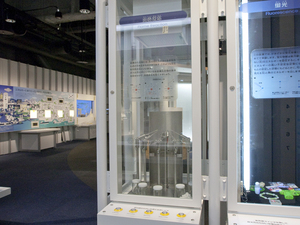Nagoya City Science Museum
TOP > Exhibition Guide > Keyword Search > Starting with "N" > natrium > Flame Reaction
Flame Reaction



Purpose of Exhibition
In this exhibition, you can observe flame reaction experiments in front of your eyes.
When materials containing alkali metal atoms are heated at high temperature and placed into a flame, the flame color is different for each element.
This reaction is called "flame reaction". Flame reaction is seen as a phenomenon of colors that is occurring in the microscopic world of the state of the electrons inside the atoms.
Additional Knowledge
Flame reaction and fireworks When soup is split on a gas burner, have you seen the flames of the gas turn yellow? Even by spreading salt over the flame of the gas, yellow flames can be seen as well. This is the flame of the sodium atoms inside the salt (sodium chloride). The beautiful colors of fireworks are using the flame reaction.
In general, red is a strontium compound, calcium compound, yellow is a sodium compound, green barium compound, cooper compounds, are used for blue, and other colors are created by mixing those.
Mechanism of the flame reaction Heating the materials at a high temperature, the atoms are separated one by one. Atoms and electrons become a high energy state (excited state) to absorb thermal energy.
When they turn to the previous stable state (Ground State), they generate different energies such as electromagnetic waves and light. The amount of energy generated is determined by the kinds of atoms. And we (with our eyes and brains) feel the difference of light colors.
The atoms in which the flame reaction is seen are limited. Only in the case where the lightening electromagnet wave is visible light, not ultraviolet light or infrared, are we able see a colorful flame.
The heat discharged by the flame of the gas burner generates and it is essential for it to turn into a piece containing atoms.
[Examples of flame reaction]
| Group | Atoms | Flame colors |
|---|---|---|
| Group #1 (alkali metals) | Lithium (Li) | Deep red |
| Sodium (Na) | Yellow | |
| Potassium (K) | Light Purple | |
| Rubidium (Rb) | Dark Red | |
| Cesium (Cs) | Blue purple | |
| Group #2 (alkali Rare Metals) | Calcium (Ca) | Orange Red |
| Strontium (Sr) | Deep red | |
| Barium (Ba) | Yellow Green | |
| Group #11 | Copper (Cu) | Blue green |
| Group #13 | Boron (B) | Green |
| Galium (Ga) | Blue | |
| Indium (In) | Dark blue | |
| Thallium (Tl) | Light green |
Copper doesn't react to flame by itself. When copper lines are put into the flame along with plastic, including halogen (chlorine, bromine, iodine), a blue and green flame reaction can be seen. This occurs due to the fact that the halogen mixture evaporates. This is called the "Beilstein Method", and it is utilized to test minimum amounts of halogen. For instance, when wrap film (it is called polyvinyl den chloride and polyvinyl chloride) is coiled and put into the flame, it turns into blue and green flame. (It is necessary for you to take full care of the harmful gas). When you burn colorful advertisements, blue and green flames can be seen. Copper phthalocyanine is utilized for the blue-and-green-color printing ink, and the color is considered a flame reaction of copper.
As we can see from the copper example, there is a case of flame reaction in which lights are generated not only from completely discharged atoms, but also from the particles. In the case of fireworks, lights come from atoms such as Na (yellow color), and in some cases, lights from particles such as Srcl (deep red), SrOH (pink), BaCl (green), CuCl (blue), CuOH (light green), CuO (light red), all colors which generate while flaming. Atoms discovered by the flame reaction In 1860, Germans, Bunsen and Gustav Robert Kirchhoff, discovered a new cesium utilizing the flame reaction and a spectroscope.
He introduced samples of the unknown material into the flame, and when viewed divided by a prism through a telescope, the light of the wave length was different from already known existing atoms. After that, through this method, rubidium and thallium were also discovered.
Colors of flames other than flame reaction(1) The red color of flameHot soot (carbon particles), highly heated light turning into orange color,Regardless of the type of substance, colors change white, red and yellow continuously at a high temperature (the white color of skyrocketing fireworks is created when metal powers like aluminum, and oxygen burn. It turns into an extremely high temperature of approximately 3000 degrees, and white lights mixing various kinds of wave lengths are generated). (2) Blue flame in gasGas blue flames are produced by unstable burning during a certain time, (chemical formula CH and C2 and OH), light is emitted.
Gas burning will cause soot and red flame due to incomplete combustion.
Article by Keiko Ishida, curator
